Nine Innings: David Price's New Vantage Point, Joe Mauer's Hall of Fame Candidacy and a Possible Reboot of the '86 Postseason
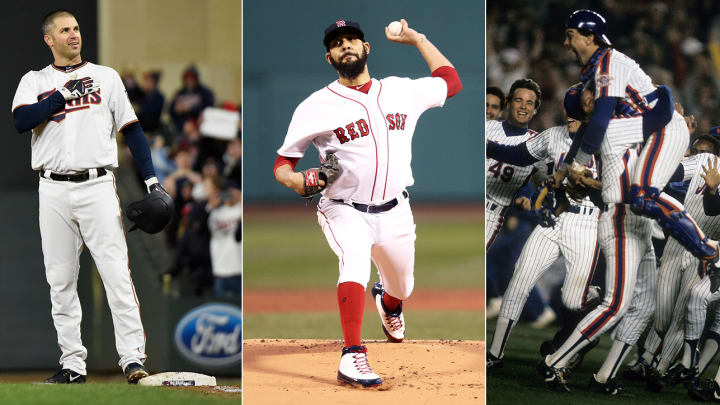
HOW DAVID PRICE TRANSFORMED INTO A LEFTHANDED VERSION OF ROY HALLADAY
By Tom Verducci
Midway through last season, saddled with a 4.76 ERA, David Price had an epiphany. It came from watching fellow Boston Red Sox lefthanders Chris Sale, Drew Pomeranz and Eddie Rodriguez throw bullpen sessions. He noticed that all of them threw from the third-base side of the rubber.
“David is very smart,” said pitching coach Dana LeVangie, then the team’s bullpen coach. “I mean, very smart. He wondered, ‘How come I’m not doing that?’”
Price had pitched almost exclusively from the first base side of the rubber since joining the Red Sox in 2016, except for a start June 24 last year, when he tried the middle of the rubber.
So on June 29, inspired by his fellow lefties, Price moved to the third base side of the rubber. He beat Minnesota that night, 6–3, with seven strong innings. Since then, and despite missing August with elbow irritation, Price has been a completely different pitcher.
Let’s start with the results, which even include a throwaway start Wednesday on a frigid night against the Yankees when he lasted only one inning because of numbness in his pitching hand. (He’s on track to return to the mound Tuesday in the warmth of Anaheim.)
Price 15 Games Before and After Switch
| W-L | ERA |
|---|---|---|
Before shift | 7-4 | 4.62 |
After shift | 5-2 | 2.02 |
Clearly something is going on here. Now look at how Price’s repertoire has changed:
Price's Two-Seam/Cutter Usage Before and After Switch
| Percentage | Slugging percentage | MLB rank |
|---|---|---|---|
Before shift | 54% | .476 | 63rd |
After shift | 76%* | .309 | First |
* Highest in MLB (min. 900 pitches)
Price has become a lefthanded version of the late Roy Halladay, who threw 70% two-seamers and cutters and as a righthander worked on the first-base side of the rubber. (Price threw almost no four-seamers when working through elbow trouble last year. His two-seam/cutter combo this year is 66%.)
The two-seamer and cutter work in tandem so well because they create a “scissors” effect. They travel with similar speeds (Price’s two-seamer is only about four mph faster than his cutter) and with indistinguishable revolutions per minute (his two-seamer spins at 2,139 rpm and his cutter at 2,109). But they bend in different directions.
Price’s two-seamer tails to his arm side and his cutter cuts to his glove side. The dilemma for a hitter is that two pitches look the same for two-thirds of their path to the plate, but then one will turn left and one will turn right. Both pitches work particularly well when they’re down in the zone.
Rangers' Bartolo Colon Perfect Through Seven Innings, Finishes With One-Hit Allowed Against Astros
“Today that’s really impressive,” LeVangie said about throwing so many pitches down, “because of what hitters want to do with launch angles. Everybody’s trying to lift.”
How did the change in the rubber help Price so much? The majority of hitters Price faces are righthanded. By moving to the third base side, he can get both the two-seamer and cutter into the hands of righthanders more easily, which opens up the outside of the plate when he wants to back-door a cutter or fade a changeup.
Many lefthanded relievers, such as Alex Claudio, Jake Diekman and Tyler Olson, like to work from the first-base side of the rubber because they want to create the greatest offset angle possible with their breaking ball. Standard operating procedure for matchup lefties means starting on the first base side with their back turned toward the batter (a “closed” pitching stance to “hide” the ball) and throwing cross-fire style.
But starters have to get out lefties and righties and do so multiple times in a game. And a cross-fire throwing style is more strenuous, so it’s not suited for someone looking to throw 200 innings.
Cubs Manager Joe Maddon Say Braves Game 'Should Not Have Been Played'
Price found another benefit to moving to the third base side, in addition to getting the ball to his glove side easier:
“His pitches are all competitive right out of the hand now,” LeVangie said, “especially his changeup.”
A pitcher who creates a large offset angle releases the ball from so far off center to the plate that the pitch often looks like a ball right out of his hand. But by releasing the ball with less of an offset—when Price releases the ball now it is a foot closer to the middle of the rubber than it was before the switch—Price makes his pitches look “competitive” right out of his hand. That means virtually all of his pitches start out looking like strikes, not balls.
With the right movement that gets his pitches to run just off the edges of the strike zone, he can create a “strike-to-ball” trajectory that induces chase swings. It’s the theory behind the famous words of Greg Maddux, who when asked to describe the key to pitching said, “Make your balls look like strikes and your strikes look like balls.”
RANK 'EM: NINE THINGS YOU MIGHT HAVE MISSED IN THE YANKEES-RED SOX BRAWL
By Gabriel Baumgaertner
1. The slide was dirty. It doesn’t matter how perfect the angle is or if you properly break up the double play; if you slide with your spikes up, it’s dirty. Children get thrown out of Little League games for sliding with their spikes up. For Tyler Austin to plead ignorance and claim it was a “totally clean” slide is foolish.
2. Joe Kelly looked like he emerged from the throes of passion. Just check out his neck!
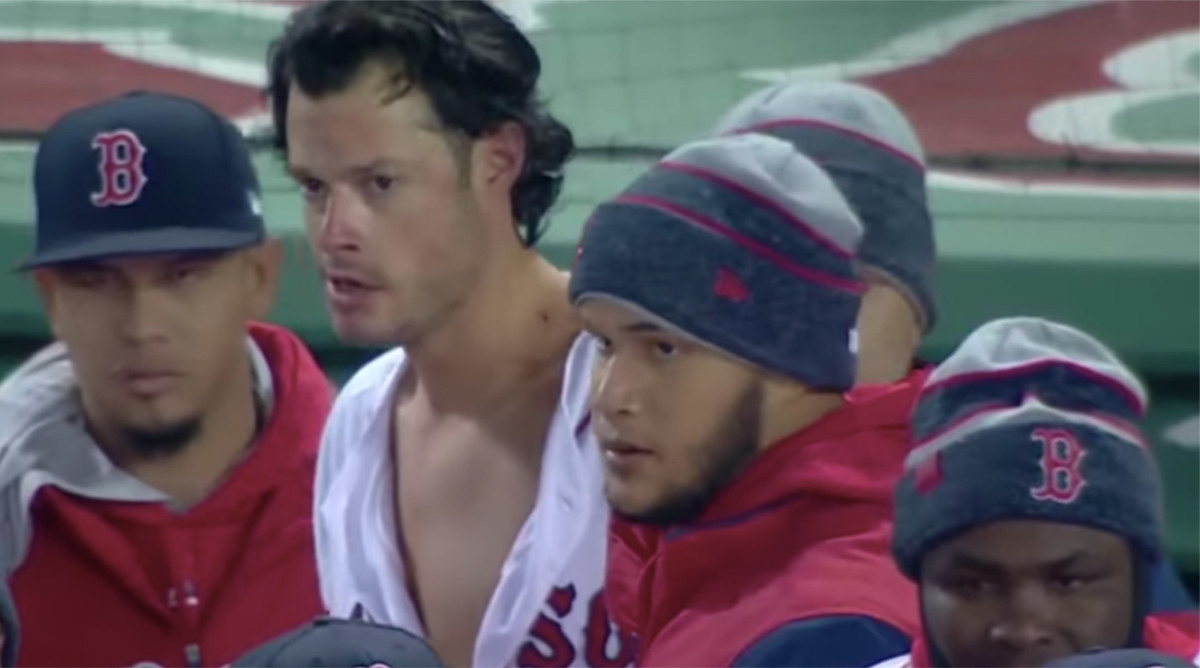
3. You have just been hit with a 95-plus MPH fastball. You also wear a rather visible cross over your baseball jersey. Two bible verses come to mind.
3a. Matthew 5: 38-41: ""You have heard that it was said, 'AN EYE FOR AN EYE, AND A TOOTH FOR A TOOTH.' "But I say to you, do not resist an evil person; but whoever slaps you on your right cheek, turn the other to him also. "If anyone wants to sue you and take your shirt, let him have your coat also.”
3b. Exodus 21: 23–25: “"But if there is any further injury, then you shall appoint as a penalty life for life, eye for eye, tooth for tooth, hand for hand, foot for foot, burn for burn, wound for wound, bruise for bruise.”
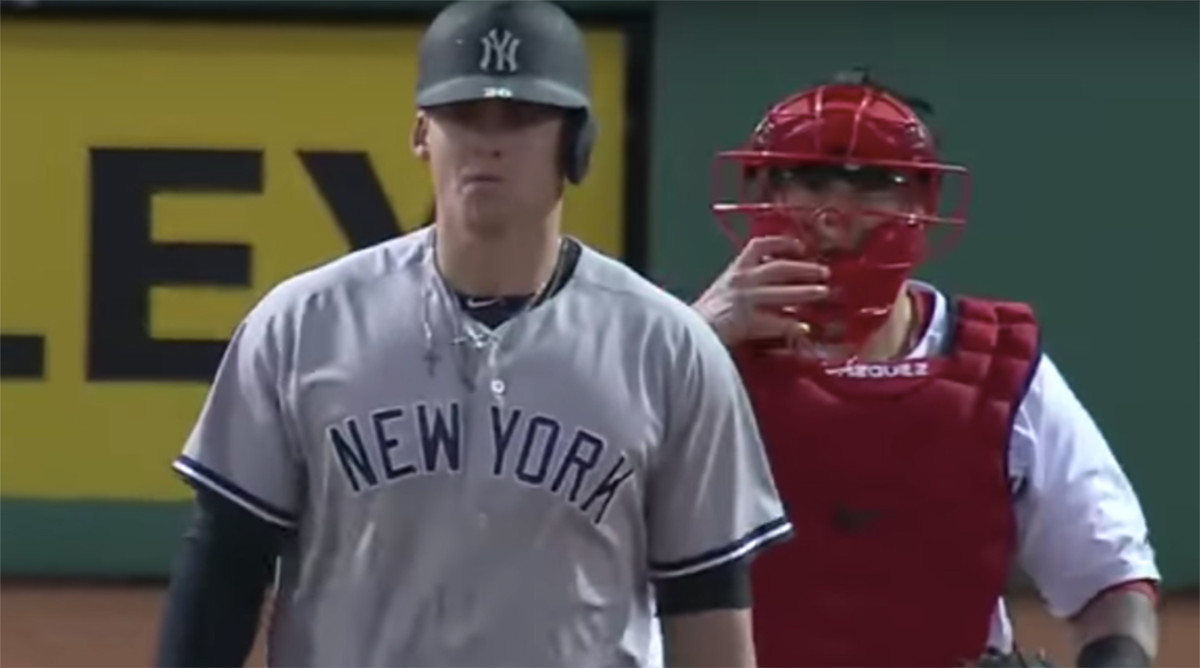
Tyler Austin must be more of an Old Testament guy.
4. Joe Kelly was READY TO RUMBLE.
5. While Kelly was trying to punch Austin, Red Sox 1B/DH Mitch Moreland (No. 18) was trying to pants him.
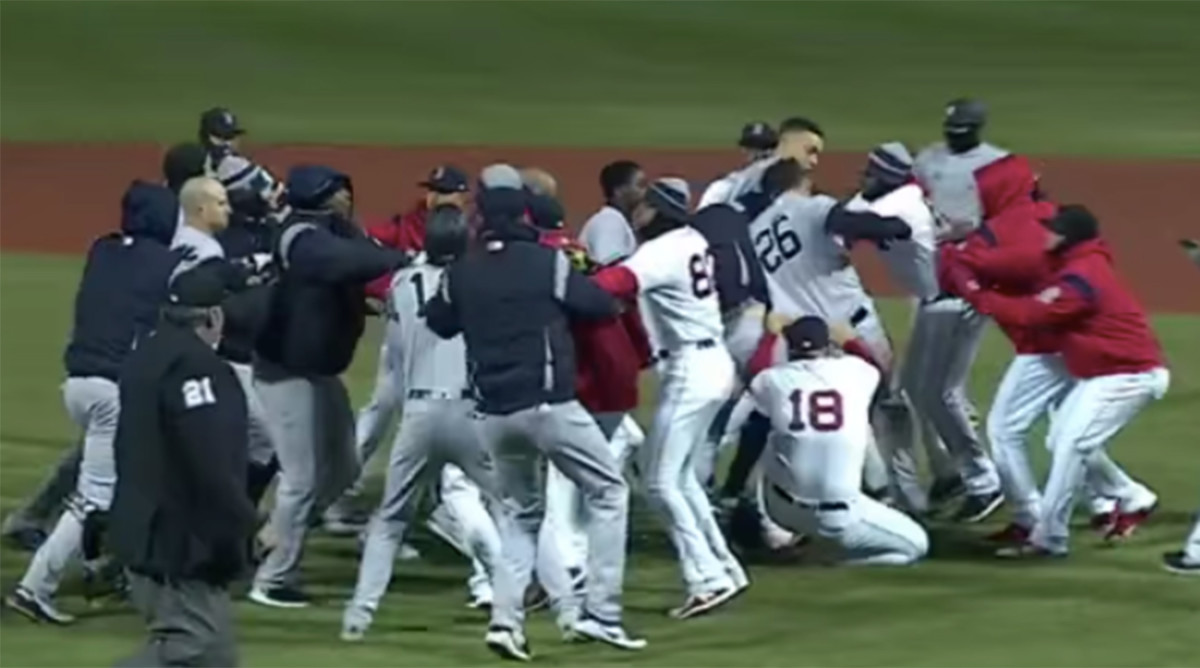
6. Yankees coach Phil Nevin and Red Sox catcher Christian Vazquez attempted to recreate this historical photo.
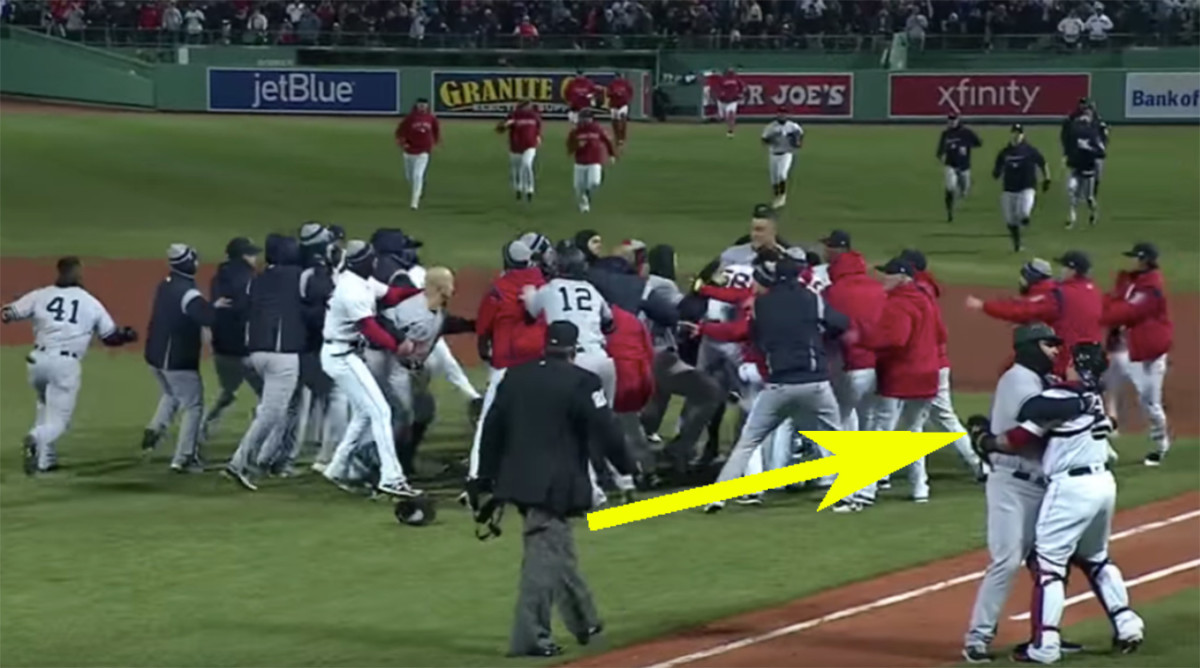
7. Joe Kelly told a ridiculous (if amusing) lie about the pitch that hit Austin.
Joe Kelly: “It was a pitch that got away on a cold night. … I walk a batter per inning. It’s not like I have Greg Maddux command.”
— Pete Abraham (@PeteAbe) April 12, 2018
8. Nevin, who was seen yelling at Red Sox manager Alex Cora for some reason, lamented his wardrobe choice and probably can’t wait for summer to start.
9. It wasn’t even the best fight of the day!
THE BEST THING I SAW THIS WEEK: GERRIT COLE REDISCOVERING HIS ACE FORM IN HOUSTON
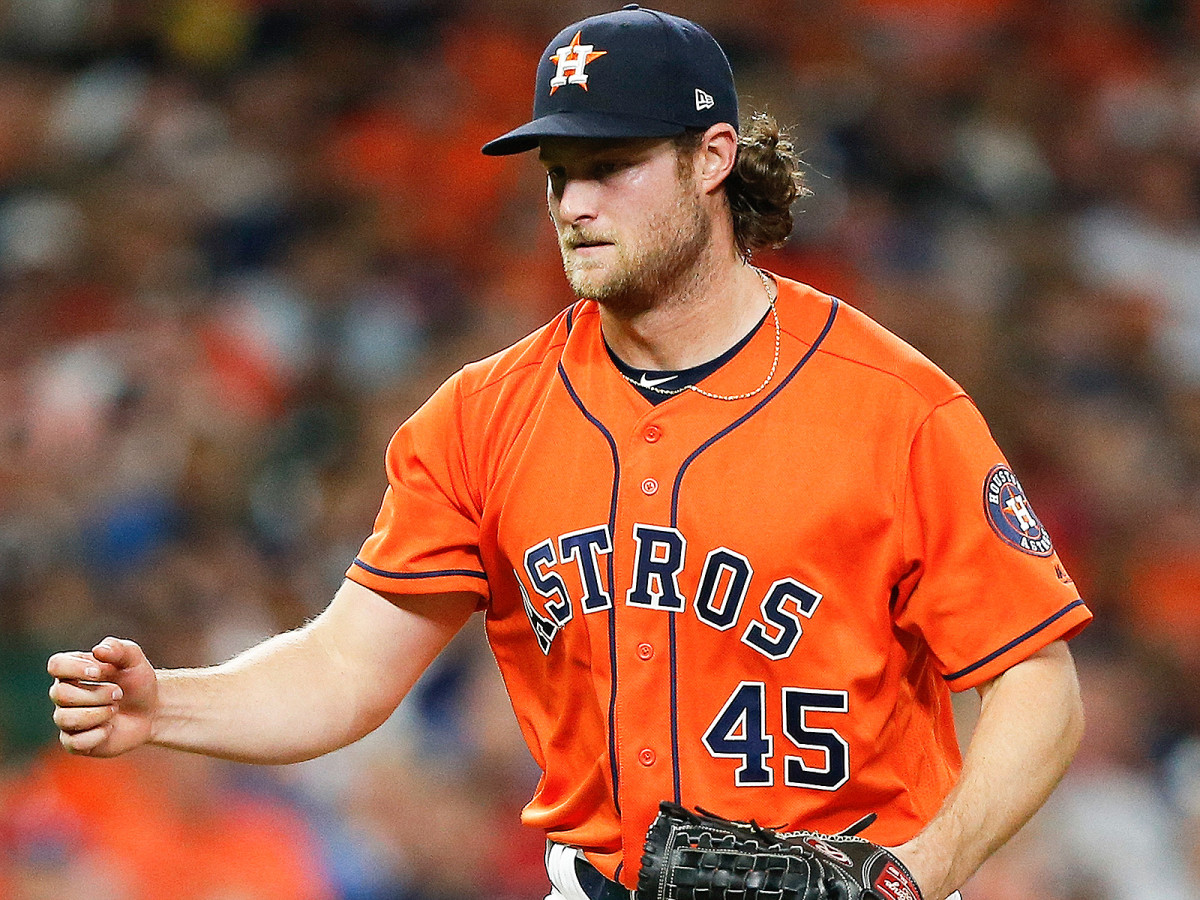
By Jack Dickey
It’s early, but the Astros’ rotation is again shaping up to be one of baseball’s best. Last year Houston’s starters had the sixth-best ERA in the league; to date in 2018, they rank second in starter ERA, behind only the 13–2 Red Sox. Their best starter, though, is not named Verlander, Keuchel, or McCullers—it has been newcomer Gerrit Cole.
On Friday, Cole made his first start against a good Rangers offense. In seven innings, he struck out 14 batters, walked one, and allowed only three hits, though two were home runs. It was Cole’s third start of the year, and he has gone seven innings and struck out double-digit batters each time. (He had only six double-digit strikeout games in 127 starts as a Pirate.) Among all starters, he is tops in average game score, and fourth in swinging-strike percentage, with hitters whiffing on 17.5% of his pitches. In no previous season for Cole has the number been higher than 10.2%.
I can’t remember which writer was the first to question the Pirates’ wisdom in dealing Cole to the Astros in January for a handful of spare parts. Everyone was stampeding to do so. Not only did Pittsburgh appear to be selling low on their 27-year-old ace, who had followed up an all-star 2015 with a shortened ’16 and a journeyman-like ’17, but they did so without exhausting all possible options to get more out of Cole. The Pirates called on Cole to embrace Ray Searage’s fastball-and-sinker-heavy organizational pitching philosophy, essentially trying to make him into Brandon Webb. But what if he’s Stephen Strasburg? Since coming to Houston, Cole has all but ditched the sinker, throwing more curveballs to compensate. It’s early, yet it’s working. Even with their 11–4 record, the Pirates must feel a twinge of regret.
ROUNDTABLE: IS JOE MAUER A HALL OF FAMER?
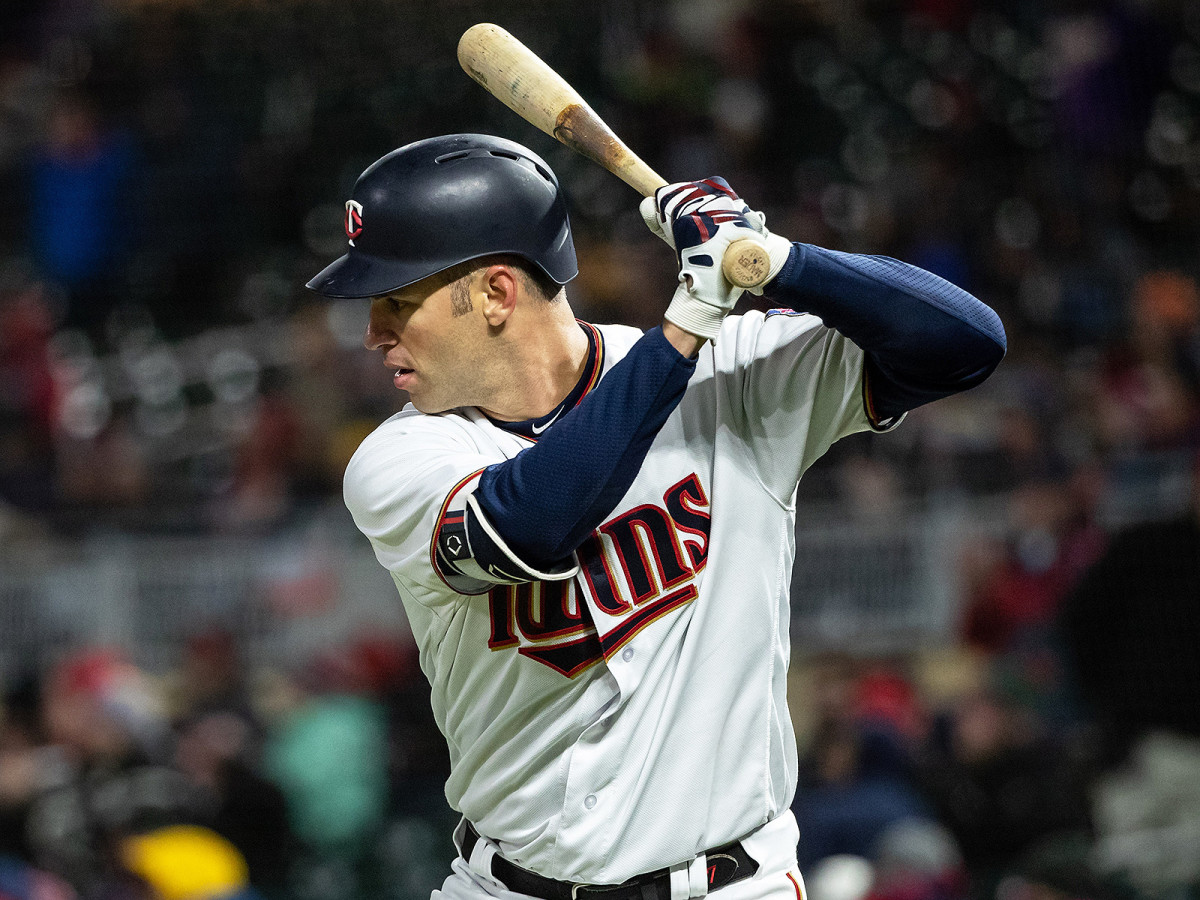
In light of Joe Mauer collecting his 2,000th his last week, the Nine Innings crew dished their thoughts on his candidacy for Cooperstown. Unrelated to Mauer's place among baseball's immortal players, the 34-year-old catcher-turned-first-baseman leads the American League with a .412 average as of this writing. He also only struck out once in high school. This is the man who caused Mauer's whiff.
Stephanie Apstein: I experienced a truly disturbing moment last fall when I saw Joe Mauer walking through the Twins’ clubhouse without his hat on. He’s … gray. I was sad. Mauer was one of the best players in the game when he was young, the first catcher in the AL to win the batting title and the first in either league to win three times. He seemed on a surefire Hall of Fame track until a series of concussions forced a move to first base after 2013. He’ll be 35 this week, and even after he picked up his 2,000th hit last week, he still has a ways to go before he accrues the longterm value Cooperstown voters will want from him. It’s hard to imagine he will get there. But he hit .315 last year, gray hair and all, so what do I know?
Gabriel Baumgaertner: Mauer is a pretty easy yes for me. For the specifics, I encourage everyone to read Jon Tayler’s thorough look at Mauer’s career, but I’ll argue much broader and far less technical points. He was the most feared offensive catcher in the game for a significant portion of his career; he still has plus power to all fields; he can’t be shifted; and maybe I’m just a sucker for hometown heroes because his story—No. 1 overall pick from a local St. Paul high school—remains one of baseball’s best.
Let's Appreciate Joe Mauer After His 2,000th Hit
Michael Beller: The historical record likely says no. Mauer doesn’t have the gaudy numbers that guarantee a spot in Cooperstown, he played fewer than 1,000 games behind the dish, and his peak, while undeniably great, was also short. If it were up to me, though, he’d be in. Mauer was one of the best pure hitters in the majors from 2006-13. In the first half of that window, ending with his 2009 MVP season, he was arguably the most feared hitter in the majors. Few catchers in MLB history have been capable of claiming that title. Given the beating concomitant with playing catcher, the heights of Mauer’s career at the plate are even more impressive. Mauer single-handedly doubled the number of batting titles won by a catcher to three from six. He’s one of 21 players in MLB history to win at least three such crowns. Only three of the 21 eligible for the Hall aren’t in—Tony Oliva, Bill Madlock and Larry Walker. He deserves to be among the majority, but his lack of power and brief peak may ultimately keep him out.
Jack Dickey: Do you remember how wretched Mike Piazza was at first base in 2004? The move was intended to prolong the great catcher’s career, but it proved to be a mess. After 2004 he played 200 more games behind the plate but never another one at first. I bring Piazza up because I assumed a similar series of events would play out in the career of Joe Mauer. He had a stellar peak, including an MVP season in 2009, but among other injuries he sustained a serious concussion in 2013, which he decided had to be his last season behind the plate. He moved to first.
Mauer hasn’t been the same kind of hitter since that concussion (and since the move), but he hasn’t been a dud, either. He’s given the Twins pretty steady two-win annual production, making him less than a star but more than a washout. What effect should these seasons have on his Hall case? I think that they help it—it shows some mettle to play first after those injuries rather than DH or retire early—and, that when he’s done, he’ll belong in Cooperstown.
A Brief History of Yankees-Red Sox Brawls
Connor Grossman: Joe Mauer will one day be enshrined in Cooperstown. He may not make it in his 10-year window on the writers' ballot, but the Hall of Fame has safety nets in place to allow players reconsideration on small committees. There are several things Mauer doesn't have: gaudy playoff numbers, remarkable longevity as a catcher or really any pinnacle moment (on the field, at least) of his career. But when fans look back on this era of baseball, from the early 2000s through 2020 or so, Mauer will stand among the defining players of that period in baseball. He deservedly held the title of best catcher in baseball for many years, and separating the positional aspect of the distinction, he served as one of the best players in all of baseball. If your greatness is essential to defining an era of baseball, you have a place in the Hall of Fame.
Jon Tayler: I tackled this subject in my appreciation of Mauer after he picked up his 2,000th career hit; suffice to say that I believe he’s in, barring something strange. Not only is 2,000 career hits a Hall checkmark, as FanGraphs’ Jay Jaffe noted last week, but Mauer adds to that an MVP award, three batting titles, three Gold Gloves, a career .309/.392/.443 line, and 54.6 Wins Above Replacement, which is eighth-best among catchers in major league history. True, he’s not a catcher any more, but no one can discount what he did at the position while he played it. Besides, Cooperstown is so thin on backstops—only 15 are enshrined—that its ranks could stand to be fleshed out. And what better choice than Mauer, a truly genial person and one of the game’s all-time nice guys? He’s not a slam dunk, but he’s a more than worthy choice.
ASIDE FROM SHOHEI OHTANI, WHO'S FUELED THE ANGELS' EARLY TURNAROUND?
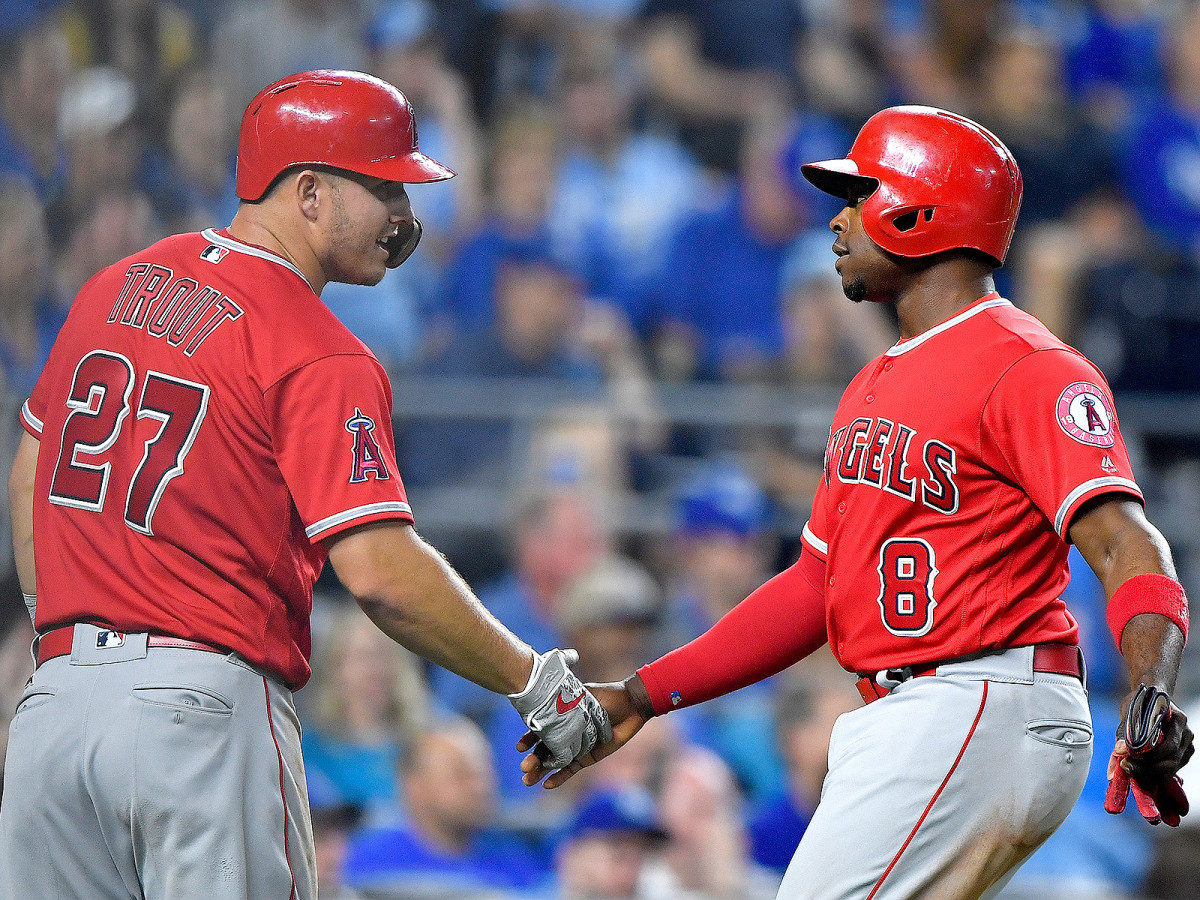
By Stephanie Apstein
One of baseball’s most pervasive myths is the importance of the stretch run. Sure, wins in September are good. But a pile of early-season wins allow late-season ones to matter. When a team plays over its head at the beginning of the year, it’s more likely to make the postseason. Not because it is now a better team but because it cannot un-win those games.
This brings us to the Angels, the biggest playoff-odds mover of the season’s first two weeks. On Opening Day, Fangraphs projected L.A. would win 86 games, good for a 39.3% chance at October. After a blistering 13–3 start—third in the game, behind the 13–2 Red Sox and 12–2 Mets—the Angels are 51.9% likely to make the playoffs, and projected to win 88.6. Those 12.6-point and 3-win changes are best in baseball.
What happened? The easy answer is that two-way star Shohei Ohtani seems to have woken up on March 29 and decided to live out all the Babe Ruth comparisons. He’s been even more than we could have imagined, such a sensation that exuberant fans have been asked to pipe down during his at bats.
The Angels Asked Fans to Quiet Down for Shohei Ohtani's At-Bats
But the guys who operate in his shadow have had just as much impact on the team’s success so far. Third baseman Zack Cozart, who picked the Angels and agreed to move from shortstop in part because GM Billy Eppler convinced him they would contend, revamped his swing a year ago and is slugging .470. Shortstop Andrelton Simmons, the best defender in the game, sports a .318 average. Even 38-year-old first baseman Albert Pujols, who was left for dead last year and moved from DH to accommodate Ohtani, has been above average. And then, of course, there’s Mike Trout. A season after the six weeks he missed with a left-thumb injury probably torpedoed his team’s playoff chances, he’s back to looking like the best player alive.
Question marks remain. Some of those players will surely slump. Seven of the eight starters in contention for slots in the six-man rotation spent time on the DL last year; three have already missed action this year, including J.C. Ramírez, who will be out until 2019 with Tommy John surgery. Ohtani is still on his first turn around the league. Opponents will likely approach him differently the second time. This was all foreseeable this spring. The Angels are still basically the team we thought they were. But that team is now closer to the postseason.
THREE UP, THREE DOWN: A FAMILIAR QUARTET OF TEAMS SOAR WHILE A PAIR OF NL SQUADS SINK
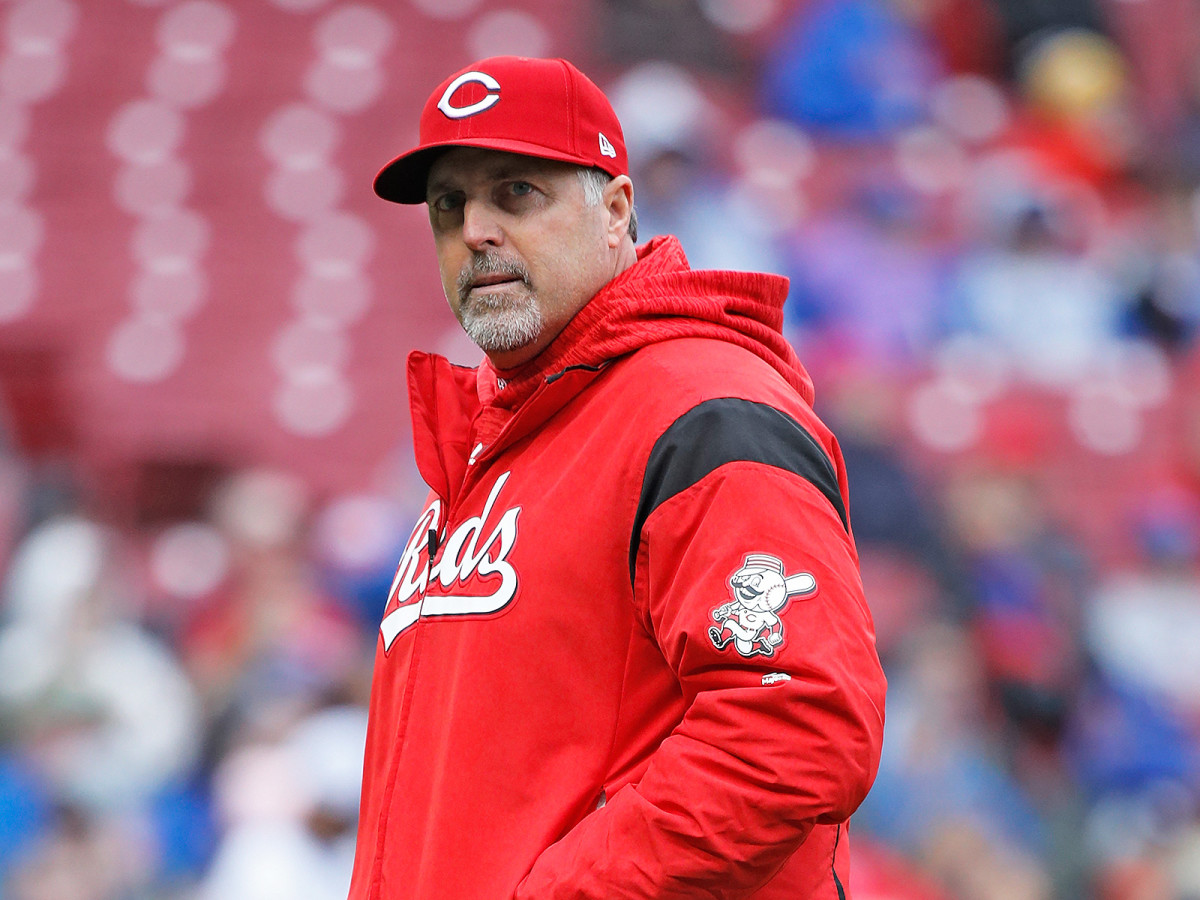
By Jon Tayler
On the rise
A 1986 Playoffs Rematch
Behold the teams with four of the best records in baseball as of Monday morning: The Red Sox (13–2), Angels (13–3), Mets (12–2) and Astros (10–6). Some of those are surprising, some less so, but all qualify as a 32-year throwback to the last time all four of those squads represented MLB’s best: 1986. That year, the Sox edged the then-California Angels in an epic ALCS, rallying from a 3–2 series deficit, while the powerhouse Mets dispatched the Astros for the NL pennant in another memorable series. We all know how that postseason ended—something about a ball getting by Buckner, if I recall. Will this quartet be able to turn this hot April start into similar October success? Fashion goes in cycles. Why not baseball, too?
Gabe Kapler
Which is the hottest team in the National League? Certainly the Mets qualify, with its best record, and the surprising Pirates are leading the Central. But in Philadelphia, what looked like a catastrophe in the making after a horrid first week for Kapler has stabilized and soared. The Phillies have won six straight after making hash of the Reds and Rays last week and now sit at 9–5.
Just as important, though, is that the harsh glare of the media spotlight is off Kapler after a series of blunders on the bench, including some bizarre bullpen management. Winning solves all issues, and few—if any—are talking about Kapler’s high-octane style now that Philadelphia’s young core is playing well. How long that lasts, though, depends on how well Kapler can avoid controversy.
Matt Chapman
It was supposed to be the other Matt in Oakland—that would be Olson—who was going to be the Athletics’ power hitter par excellence (or at least pair up with Khris Davis as the team’s top slugger). Instead, it’s Chapman who’s emerged as the beast of the Bay Area, hitting .333/.403/.650 with five homers in 16 games. That home run total ties him for third across the league with some expected faces (Davis, Joey Gallo, Eric Thames) and some less likely names (Ozzie Albies, DJ LeMahieu, and Padres infielder Christian Villanueva). Chapman's power paired with his stellar glove, meanwhile, makes him the game’s most valuable non-Ohtani player, per FanGraphs; his 1.4 WAR is tops among hitters, edging out an MVP in Mike Trout and, uh, Corey Dickerson. He may not be the Matt we expected, but he’s currently MLB’s best.
Gabe Kapler Is an Analytics Fanatic Addicted to Fitness. Are Phillies Fans Ready to Embrace Him?
On the decline
Bryan Price’s employment prospects
To be fair to Price, the manager of the beleaguered Reds: It’s not his fault that his team is a total trash fire. Cincinnati owns the league’s worst record (2–13) and ERA (5.83), has scored the fewest runs in the NL (44) and allowed the most in MLB (92), and is mired in an eight-game losing streak. That’s by design, sort of: The Reds, currently in an endless rebuild, are bereft of talent after dealing most of it away over the last four seasons. But Price will ultimately and likely be out of his job for a start this awful, if only because Cincinnati barely looks competitive, even for a tanking team. Price has never really shown any signs of being anything special as a manager, and his loss won’t be a big one. But it does raise the question of just what, exactly, the plan is in the Queen City right now—and if anyone at all can execute it.
The Giants’ bounceback chances
We all expected better this year from the Giants after last season’s 98-loss debacle, a fair assumption after adding Andrew McCutchen and Evan Longoria in the offseason. But here they sit, at a not-so-nice 6–9 after getting blitzed in three-of-four games by the lowly Padres. The rotation is an injury-riddled mess, down Madison Bumgarner, Johnny Cueto and Jeff Samardzija, but more problematic is the offense. Save the dependable Buster Posey and his Mini-Me, Joe Panik, no one is hitting well. It’s been especially bad for the new guys: McCutchen has a dramatic walk-off homer to his name but a .203/.288/.339 line otherwise, and Longoria isn’t much better at .204/.218/.407.
All told, the Giants’ .682 OPS is third worst in the NL, and they’ve scored only 46 runs in 15 games—third fewest in all of baseball. That’s of a piece with last year’s incompetence at the plate, which has to be a worrying thought for a team that’s already old and got even older this winter.
Manny Machado’s time in Baltimore
It doesn’t feel too early to suggest that the Orioles simply aren’t good. Their three-game shellacking at the hands of the Red Sox this weekend both dropped them to 5–11 on the season—already 8 1/2 games out of first place in the AL East—and confirmed that Baltimore doesn’t look like a contender. As expected with the Orioles’ paper-thin pitching staff, the team has allowed the most runs in the AL (86), with only Dylan Bundy and Andrew Cashner pitching even remotely well. New arrival Alex Cobb was destroyed in his Baltimore debut against Boston, surrendering eight runs in 3 2/3 innings, and Chris Tillman looks utterly finished as a big leaguer (15 runs allowed in 11 2/3 frames). And as Baltimore sinks further, the clock continues to tick on Machado as an Oriole as free agency looms. He’s off to a good start, hitting .308/.392/.523, but it increasingly looks like he’ll be doing his second-half work for another team.
EMPTYING THE NOTEBOOK: KIMBREL'S SIX-OUT ASSIGNMENTS, JUDGE'S EYE-OPENING NUMBERS AND MORE
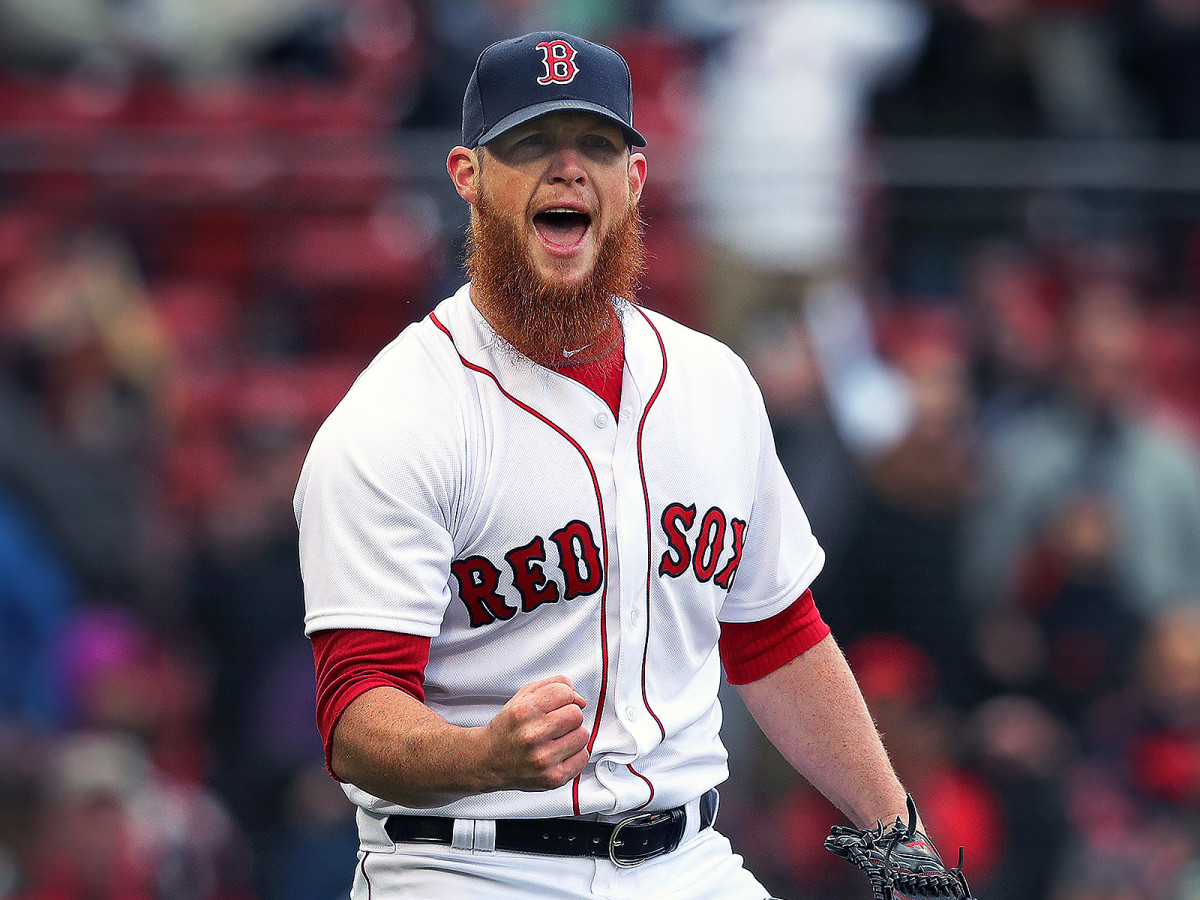
By Tom Verducci
Yankees pitching coach Larry Rothschild has done a fine job getting Sonny Gray and Dellin Betances to speed up their deliveries. Gray had become slower and slower in his delivery, failing to take advantage of his athleticism. He’s getting closer to the speed of his delivery when he arrived in the big leagues. Betances needs to quicken up, not only so he can throw more strikes but also to keep runners from turning games into a track meet. Said manager Aaron Boone, “You want to prevent the guys who are not base stealers from stealing.” Betances still lacks true fastball command. When he needs to throw a strike, he leans on his breaking ball.
**
Durability is a skill. Rick Porcello made career start number 277 at age 29 years and 107 days. Since the DH was adopted in 1973, here are the most American League starts at that age:
1. Felix Hernandez, 323
2. Rick Porcello, 277
3. Mike Witt, 272
4. Frank Tanana and CC Sabathia, 271
How good was Porcello against the Yankees last Thursday? He threw seven shutout innings by throwing pitches at 15 different speeds: 76, 78, and every number from 80 to 92. The average major league fastball is 92.4 mph. All 99 pitches Porcello threw were below major league average fastball velocity.
**
Here’s how much Boston manager Alex Cora values the head-to-head games against the Yankees: on the first day closer Craig Kimbrel showed up in training camp, Cora sat down to talk to him about getting six-out saves against the Yankees. Kimbrel quickly signed on for such duty. He was on standby last week for two-inning saves against New York. The scenario where Cora would do it: holding a lead and facing the top of the Yankees lineup to start the eighth. (It didn’t come up. Stay tuned.)
Kimbrel has 295 regular season saves—none of them that required more than four outs.
**
The more you watch Aaron Judge play the more you have to be impressed by his work ethic and baseball intelligence. The evidence:
• After hitting .179 in a 2016 cameo, he went home and changed his swing. He came back and led the league in home runs and was MVP runner-up.
• Last year he hit .185 in August, as teams like the Red Sox consistently beat him with high fastballs. He closed that hole and hit .311 in September.
• Last year he saw more sliders (703) than anybody in baseball and was worse at hitting them (.158) than anybody in baseball except Mark Reynolds and Jose Bautista. This year he’s hitting .588 against sliders (10-for-17)—the best batting average on sliders in all of baseball.
Truly remarkable. Also remarkable: when Tyler Austin charged Joe Kelly to start that brawl Wednesday, guess who was the first one into the fray, sprinting across the field to get Kelly in a headlock—when his spot in the order was still four spots away? That’s right: Judge. Despite Judge’s calm exterior, Yankees officials rave about his focus, intensity and competitiveness.
100 WORDS ON A PLAY YOU NEED TO SEE: AUSTIN HEDGES TURNS DOUBLE PLAY FROM THE SEAT OF HIS PANTS
[youtube:https://www.youtube.com/watch?v=wY5TL6Yonks]
By Michael Beller
I’ve watched this play 10 times now, and I still can’t decide which part is most impressive. First, there’s the way Austin Hedges quickly changed direction after Gregor Blanco pops up a bunt. Then he tracks the popup while never fully having his footing. After that, he falls while making a lunging grab. Then he throws a perfect strike to Eric Hosmer at first—about a 100-foot toss—to double off Brandon Crawford. Each component is admirable, but the throw is most impressive. You don’t see catchers make perfect, chest-high throws on a rope from their butts all that often.
FROM THE VAULT: THREE BASEBALL PLAYERS WALK INTO A RESTAURANT
By Connor Grossman
To get the time peg out of the way, Don Mattingly turns 57 this week. Unless his managerial career takes an unexpected, Joe Torre-like turn, he's not going to be enshrined in the Hall of Fame. However he did sit and talk hitting with two Cooperstown legends, as recorded in this SI piece from Peter Gammons. Mattingly, Ted Williams and Wade Boggs converged in one Florida restaurant before the 1986 season, and I'll let this SI Vault excerpt take it away...
MATTINGLY: All good hitters shift their weight. I can't believe they don't. Show me how you get back.
WILLIAMS: I'm doing it with my hips.
BOGGS: Cock your leg. Where's your weight going?
WILLIAMS: Which way am I shifting my weight?
MATTINGLY: I think you're shifting it back.
WILLIAMS: Only because it's the only way I can stand. O.K., watch me swing. I drop my back shoulder. I don't have to force myself to keep my head down. [Boggs takes his swing.] You're dropping your back shoulder, too.
BOGGS: That's the way I hit, and you try to say I don't hit like that.
WILLIAMS: I didn't say that. I never told you a thing about your swing. Your hands are right, but you don't practice the way you hit. When you get in the cage, you swing through with your head straight down—Dewey Evans pretty near makes me vomit the way he swings.
